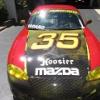it would be nice to test the BFG tire to see the pros and cons. I am no tire engineer either.

How hard do you want it when it's wet ??
#21

 Posted 11-16-2015 11:45 AM
Posted 11-16-2015 11:45 AM

#22

 Posted 11-16-2015 11:49 AM
Posted 11-16-2015 11:49 AM

what about an open rain tire?
That is THE MOST EXPENSIVE OPTION EVER - now you would consider bringing multiple brands of tires to various tracks, dependent on weather and track conditions
personally would just prefer a harder compound, one that doesnt wear off the sharp edges and shoulders in one session. While the RA-1 is NOT a rain tire per-se, it DOES MAKE AN EXCEPTIONALLY AFFORDABLE RAIN TIRE FOR OUR CLASS (one set would last more than a season of rain racing for most, some would get several seasons out of it depending on usage.
Something similar would be a step in the right direction
- steveracer likes this
Danny
Danny Steyn Racing | DSR YouTube Channel
Danny Steyn Photography | Adept Studios | Ocean Machinery | OPM Autosports | Rossini Racing Engines | G-Loc Brakes |
2 x SCCA Runoffs Champ | 1 x NASA National Champ | 6 x June Sprints Champ | 10 x ARRC Champ
1 x SCCA Super Sweep | 2 x Triple Crown | 4 x Hoosier Super Tour Points Champ | 6 x Majors Points Champ | 5 x SEDiv Driver of the Year











#23

 Posted 11-16-2015 12:43 PM
Posted 11-16-2015 12:43 PM

Is he suggesting looking at some different MFG's before the next contract ?
J~








#24

 Posted 11-16-2015 01:17 PM
Posted 11-16-2015 01:17 PM

First off, I fully agree that the H20 is an incredibly expensinve rain tire due to how the performance drops off. I personally love racing in the rain and have had several experiences allong with everyone else deciding if I want to go out on slow tires, or ruin a set of fast tires. That being said, just asking for a harder tire sounds great, but may be overly simplistic.
I'm not a tire engineer but I do have a healthy background in materials R&D. When you read up on the scientific literature on racing tires (which I have) you find there are multiple variables involved. One of the things going on is that as the tires are heating up and sliding around on the racing surface, the rubber molecules are making and breaking mollecular bonds with their neighbors. Whether you want to call it cross-linkng, curing, or heat treating, it changes the physical properties of the rubber. It's not simply that the tires fall off as the tread wears.
What I'm hearing is that people aren't complaining about the grip after that heat cycle (we want a harder tire) as much as that they have one magic heat cycle. Here's the potential problem: Just going to a harder rubber compound does not ensure that there will not be a magic heat cycle on the new tires as well. Avoiding that initial round of mollecular cross-linking would likely require some kind of post-mold heat treatment and there we are really asking the tire manufacturer to make a more expensive tire due to the additional process requirements (and R&D to get it right) all with the aim of slowing down the tire as a sticker so that it more closely resembles an older tire. A harder tire may help, but it's not garuanteed to be a magic bullet.
Agreed, mostly, which is why I asked if people know whether performance drops off primarily due to heat cycles or due to actual wear such as knocking the sharp edge/corners off. I would doubt whether they get enough heat in them under full wet conditions to make much difference (other race rubber needs ~180 degrees or more). As things start to dry you may get up there quickly, but you also knock the shoulders off. Which is more critical? (BTW, I don't think the effective spring rate of a cycled tire changes enough to be a relevant factor.)
I think the tread pattern and its ability to channel water is more important than how soft the compound is (obviously). Not that a soft tire isn't better, in part perhaps because it better flexes and forms to the road surface to "pump" water? But if there is a big difference I doubt that it is primarily a result of changes to the compound.
Has anyone checked them with a durometer new and after they fall off?


#25

 Posted 11-16-2015 01:30 PM
Posted 11-16-2015 01:30 PM

Agreed, mostly, which is why I asked if people know whether performance drops off primarily due to heat cycles or due to actual wear such as knocking the sharp edge/corners off. I would doubt whether they get enough heat in them under full wet conditions to make much difference (other race rubber needs ~180 degrees or more). As things start to dry you may get up there quickly, but you also knock the shoulders off. Which is more critical? (BTW, I don't think the effective spring rate of a cycled tire changes enough to be a relevant factor.)
I think the tread pattern and its ability to channel water is more important than how soft the compound is (obviously). Not that a soft tire isn't better, in part perhaps because it better flexes and forms to the road surface to "pump" water? But if there is a big difference I doubt that it is primarily a result of changes to the compound.
Has anyone checked them with a durometer new and after they fall off?
IMHO the drop off is a NOT a result of the soft compound heat cycling. IMO it appears to be the result of the soft compound not resisting the wear. The sharp edges wear fast as do the shoulders. This is true EVEN in fully wet conditions. One fully wet session will transform the fast hero rain tire into a decent but slower rain tire. One drying session will transform the hero rain tire into a useless test day drift tire.
My Daytona H2O's with one heat cycle were almost as soft as the new sticker H2O's, but the edges and shoulders were gone.
Danny
Danny Steyn Racing | DSR YouTube Channel
Danny Steyn Photography | Adept Studios | Ocean Machinery | OPM Autosports | Rossini Racing Engines | G-Loc Brakes |
2 x SCCA Runoffs Champ | 1 x NASA National Champ | 6 x June Sprints Champ | 10 x ARRC Champ
1 x SCCA Super Sweep | 2 x Triple Crown | 4 x Hoosier Super Tour Points Champ | 6 x Majors Points Champ | 5 x SEDiv Driver of the Year











#26

 Posted 11-16-2015 02:24 PM
Posted 11-16-2015 02:24 PM

That is THE MOST EXPENSIVE OPTION EVER - now you would consider bringing multiple brands of tires to various tracks, dependent on weather and track conditions
personally would just prefer a harder compound, one that doesnt wear off the sharp edges and shoulders in one session. While the RA-1 is NOT a rain tire per-se, it DOES MAKE AN EXCEPTIONALLY AFFORDABLE RAIN TIRE FOR OUR CLASS (one set would last more than a season of rain racing for most, some would get several seasons out of it depending on usage.
Something similar would be a step in the right direction
your to quick, i edited that post, but if your going to discuss options that is one of them. but to debate the point, how would it be more expensive than it is. the H20 is likely the most expensive option allowing a budget racer to chose less performance and more life would be saving money, If you want to be at the pointy end, your going to do what your doing now.
I am not saying i am in favor, just throwing out the options.
Frank
TnT Racing
SCCA Ohio Valley Region




#27

 Posted 11-16-2015 02:27 PM
Posted 11-16-2015 02:27 PM

One more question, is there a consensus if tire siping and re grooving is permitted?
Frank
TnT Racing
SCCA Ohio Valley Region




#28

 Posted 11-16-2015 02:31 PM
Posted 11-16-2015 02:31 PM

it is not legal.One more question, is there a consensus if tire siping and re grooving is permitted?
Open tires are definitely the most expensive. The dirt stocker is supposedly even faster but is bald after one wet session. No experience with it, but have heard that.
Also, whatever tire company we contract with, they will not want anything but their tires on the cars with the contract, so I doubt "open" is an option
East Street Auto Parts
Jim@Eaststreet.com
800 700 9080













#29

 Posted 11-16-2015 02:40 PM
Posted 11-16-2015 02:40 PM

IMHO the drop off is a NOT a result of the soft compound heat cycling. IMO it appears to be the result of the soft compound not resisting the wear. The sharp edges wear fast as do the shoulders. This is true EVEN in fully wet conditions. One fully wet session will transform the fast hero rain tire into a decent but slower rain tire. One drying session will transform the hero rain tire into a useless test day drift tire.
My Daytona H2O's with one heat cycle were almost as soft as the new sticker H2O's, but the edges and shoulders were gone.
Which makes sense to me. I asked previously if anyone tried to re-square them on a tire shaver. Is it worth a try? When the Toyo 888s were graining I put the rear on stands, put it in 1st, and used a bindi rasp to shave them smooth. Probably not quite the solution here, but it worked in a pinch at the track!


#30

 Posted 11-16-2015 04:16 PM
Posted 11-16-2015 04:16 PM

Agreed, mostly, which is why I asked if people know whether performance drops off primarily due to heat cycles or due to actual wear such as knocking the sharp edge/corners off. I would doubt whether they get enough heat in them under full wet conditions to make much difference (other race rubber needs ~180 degrees or more). As things start to dry you may get up there quickly, but you also knock the shoulders off. Which is more critical? (BTW, I don't think the effective spring rate of a cycled tire changes enough to be a relevant factor.)
I think the tread pattern and its ability to channel water is more important than how soft the compound is (obviously). Not that a soft tire isn't better, in part perhaps because it better flexes and forms to the road surface to "pump" water? But if there is a big difference I doubt that it is primarily a result of changes to the compound.
Has anyone checked them with a durometer new and after they fall off?
I've had them heat up in a drying session where they actually wore the middle of the tire and not the edges. You could tell that the tire heated up enough that it expanded more to the middle, and was actually sliding on the rasied middle of the contact patch without rolling over. It still resulted in a crappy tire but that just goes to show that there is not a single variable responsible for the tire behavior. I've also had them wear very little before just being really crappy so there is defininately not a direct relation between tread wear and grip.
I don't want to get into a full blown physics discussion but there are a few non-linear variables all playing together to create grip and they change before and after a tire breaks away. For example: in addition to vertical spring rate, there is also a horizontal one as well which has a lot to do with how much the tire twists before it lets go and whether it does so suddenly or gradually. That elasticity is not hardness either. They are related, but still very different. Tires don't even follow classical laws of friction we learn in basic physics. If they did, we couldn't corner over 1G without aero. We can and do though because of the other variables at play.
Ability to channel water is a big factor when there is a lot of water to move. The tire gets much worse when there is still a lot of tread so that's not it by itself. The tire will lose grip without significantly rounding off the edges, so it's not just the shape. Also, as the edges wear, that reduces camber so there is more of a contact surface under breaking and the sharp edge of a sidewall should not benefit braking. Do they only get worse going around corners? I think they get a lot worse under braking too.
Bottom line and I'll get off my theoretical soap box: I think that hardness is related to the issue but just stating it's the hardness of the rubber compound is an over simplification that ignores the physics of mechanical grip.



#31

 Posted 11-16-2015 04:54 PM
Posted 11-16-2015 04:54 PM

I don't want to get into a full blown physics discussion
Are you sure ? We have time.
J~








#32

 Posted 11-16-2015 06:51 PM
Posted 11-16-2015 06:51 PM

Are you sure ? We have time.
J~
http://www.engr.colo...re Modeling.pdf
Feel free to read and discuss! ![]()



#33

 Posted 11-16-2015 09:24 PM
Posted 11-16-2015 09:24 PM

- Keith Novak likes this


#34

 Posted 11-17-2015 06:43 PM
Posted 11-17-2015 06:43 PM

I know where this idea is headed, but....how about 200TW like the ChumpCar and World Racing League cars. They are cheap and last a long time, even in the dry.
OK, sorry for that interruption.
0 user(s) are reading this topic
0 members, 0 guests, 0 anonymous users




 Sign In
Sign In Create Account
Create Account




 Back to top
Back to top Report
Report






